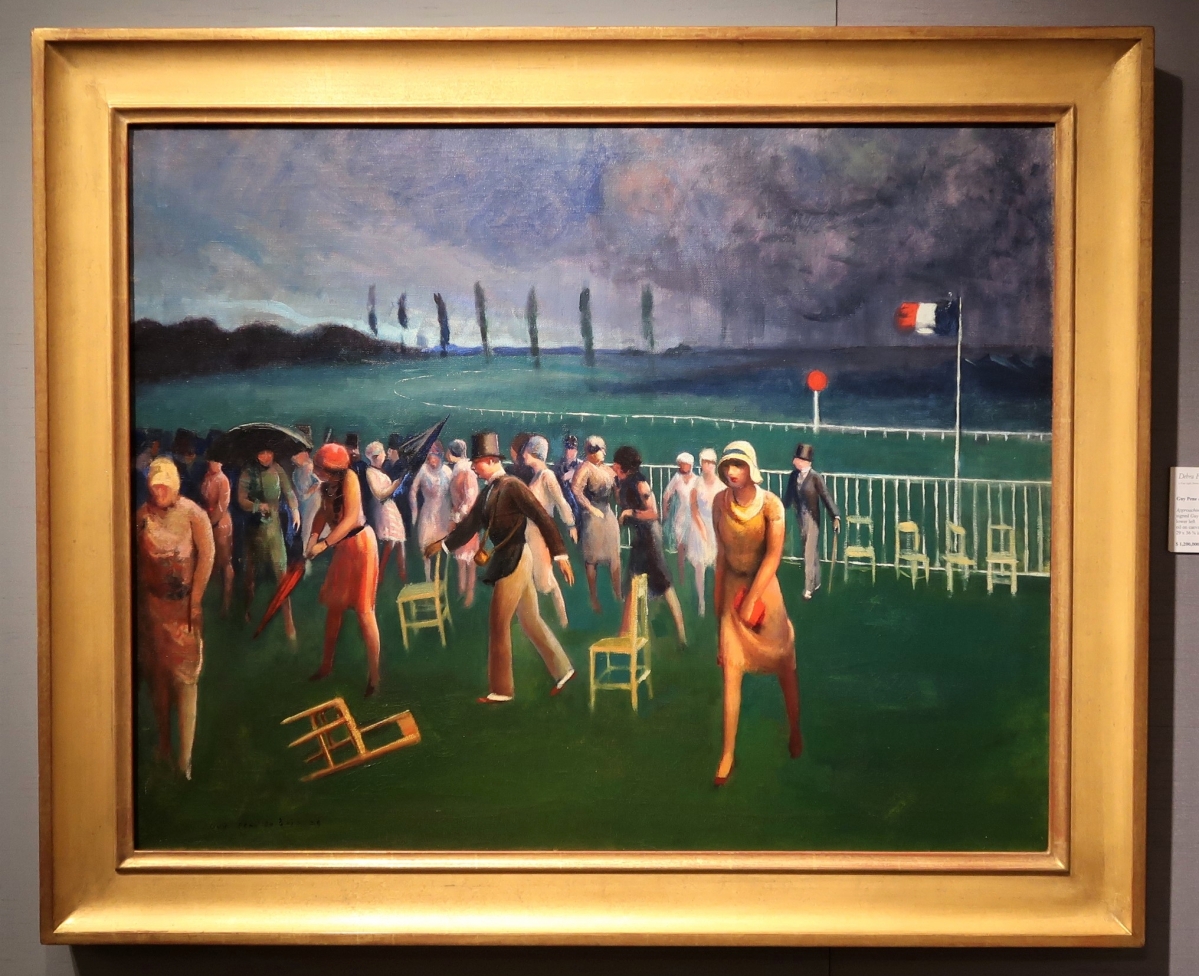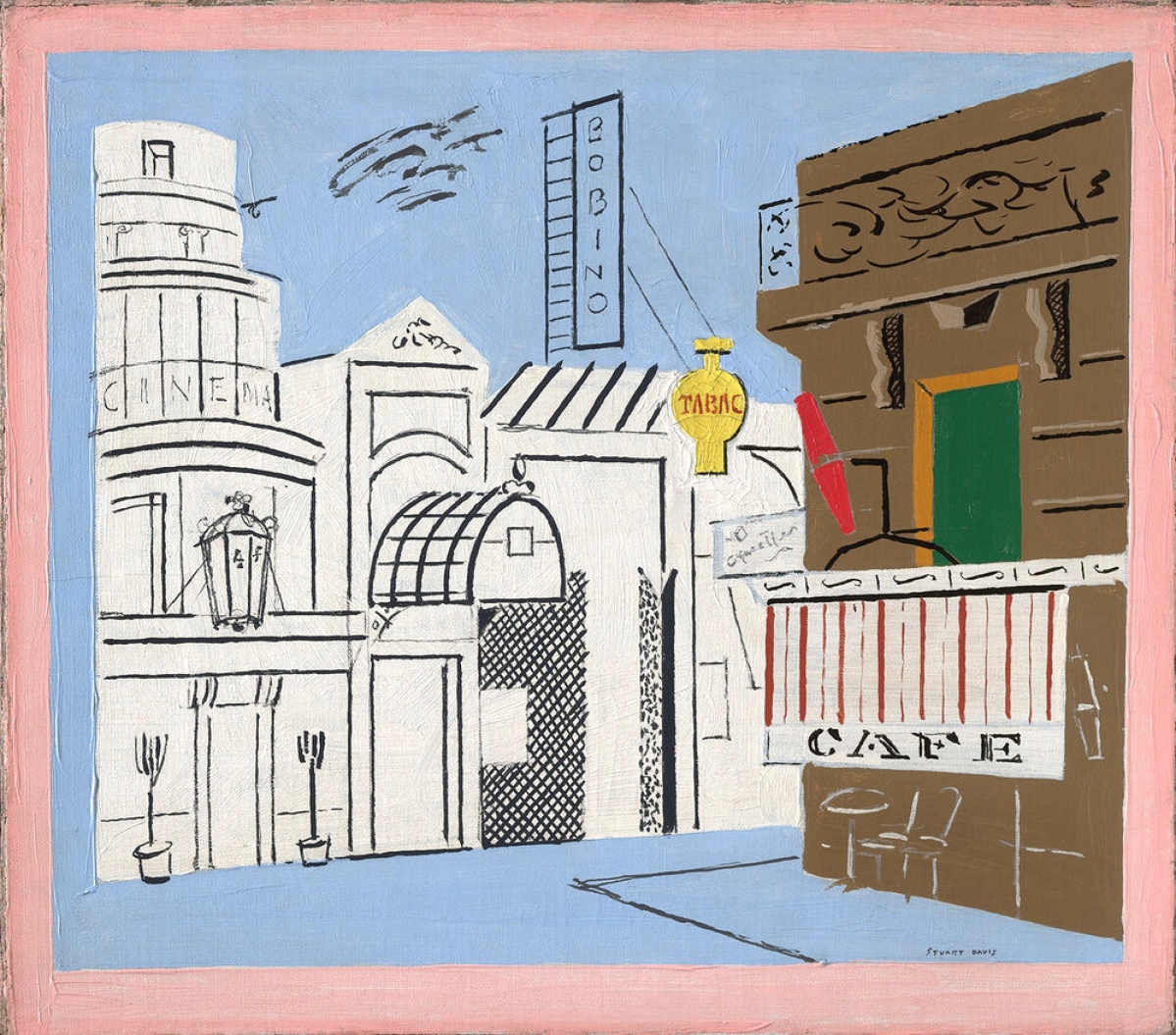
“Gas Alarm Outpost, Argonne” by Horace Pippin, 1931, oil on fabric. Right and left are works Marsden Hartley. Alexandre Gallery, New York City.
Review and Photos by Laura Beach
NEW YORK CITY – The American Art Fair is like haiku: rigorously concise and exquisitely expressive. Confined to 17 compact displays on three consecutive floors of the Bohemian National Hall on Manhattan’s Upper East Side, it manages to convey at a glance the breadth, depth and imaginative range of what the top dealers in mostly pre-contemporary American art have to offer.
Now in its twelfth year, the show, conceived as a companion to New York’s big fall auctions of American art and owned by Connecticut dealer Thomas Colville, opened with a by-invitation-only preview on Friday, November 15, and closed four days later. But while diminutive, the event expertly directed by Catherine Sweeney Singer boasted more quantity and variety than the auctions. The big two offered only 160 lots, displayed notable gaps in many sub-specialties and had disconcertingly low sell-through rates, perhaps reflecting more activity in private-treaty sales.
Rushing to catch a plane as American Art Week came to a close, Colville told us, “We had our best attendance in the fair’s twelve years, and it was standing room only at most of our lectures. We seem to have hit our stride. The show is a destination in its own right. Its quality speaks for itself.”
Echoing Colville’s remarks, Debra Force noted, “We saw people who haven’t been to the fair in a couple of years, and there were more museum curators from all over the country.” The New York dealer’s sales included “The Snake and the Bird,” a 1937 hooked rug by Marguerite Zorach; and “Woman Washing Her Hair,” a carved wood relief by Elie Nadelman. In a nod to the Jewish Museum’s popular exhibition “Edith Halpert and the Rise of American Art,” many exhibitors brought work by artists associated with Halpert’s Downtown Gallery.
“Part of the show’s success this year can be directly attributed to the fact the auctions were contiguous for the first time in several years. This meant that out-of-town American art buyers didn’t have to choose one sale or the other to make their travel plans,” said Eric Baumgartner, senior vice president at Hirschl & Adler Galleries, noting that curators regarded the fair as a “cost-effective way to survey the state of the American art market in one quick trip to New York.”

Andrew Goffman, Sara Bliss Cohen and Judy Goffman Cutler with the 1931 oil on canvas “Volunteer Fireman” by Norman Rockwell, reproduced in the Saturday Evening Post the same year.
Admission to the American Art Fair is free, as were the quartet of scholarly programs that enlivened the weekend. The programs reflected new scholarship and current museum displays, offering exhibitors a chance to show related material. While independent scholar Avis Berman was speaking on William Glackens, Bernard Goldberg Fine Arts was selling a captivating ink, pencil and wash drawing by the Philadelphia-born artist. Curator Erica Hirshler lectured on Hyman Bloom, the subject of a Museum of Fine Arts, Boston, display and a dramatic feature of the Alexandre Gallery booth. Stephanie Herdrich talked about Winslow Homer, whose rare, beautiful 1880s etchings “Saved” and “The Life Line” were highlights at Avery Galleries. Curator Barbara Haskell previewed her upcoming Whitney Museum exhibition “Vida Americana: Mexican Muralists Remake American Art.” The influence of those muralists reverberated at Hirschl & Adler, which hung two paintings by Everett Gee Jackson, a Texas artist who fell under the muralists’ spell in the 1920s.
Though not avant-garde, the American Art Fair gives shape to some broad trends afoot in the American art market. Prominent among these is the wide acceptance of illustration art as an important expression of the American experience. Work by illustrators and their progeny dominated the auctions while also surfacing in a half dozen American Art Fair booths, most notably at American Illustrators Gallery. New to the show, gallery owner Judy Goffman Cutler led with Norman Rockwell’s “Volunteer Fireman,” published in the Saturday Evening Post in March, 1931. The affiliated National Museum of American Illustration in Newport, R.I., is honoring the centennial of American women’s right to vote and the twentieth anniversary of the museum with the exhibition “The American Museum.”
Seeking to redress past oversights, American museums are diversifying their collections, adding art by women and minorities at an accelerating pace. The Baltimore Museum of Art, for instance, recently announced it would acquire only work by women artists in 2020. Eager to assist, dealers are showing overlooked and underpriced talent.
On the American Art Fair’s third floor, Kraushaar Galleries, D. Wigmore Fine Art and Taylor Graham met the challenge. Kraushaar Galleries’ Katherine Degn mounted pieces by Neel, Slobodkina, Ryan, Dehner and Rothschild, all women working in the mid-Twentieth Century.
“This was our second year at the show. We were delighted,” said Degn, who paired Marguerite Zorach’s sympathetic 1925 portrait of Bea Ault with a drawing of the subject by her first husband, artist George Ault. On another wall were depictions of Dogtown, in Gloucester, Mass., as conceived in different decades by John Sloan, Marsden Hartley and William Kienbusch.
Bronzes by the African American sculptor and printmaker Elizabeth Catlett figured at Taylor Graham, where Catlett’s patinated bronze “Fluted Head” of 1991 paired with the ethereal “Blue Form” by Vivian Springford of 1963.

At Debra Force Fine Art, “The Snake and the Bird,” a 1937 hooked rug by Marguerite Zorach, $135,000. “Fishermen’s Children,” a 1919 oil by her husband, William, below left, $245,000. Robert Laurent’s carved alabaster bust “La Toilette,” circa 1940, was $110,000.
“The intimacy of 17 dealers is what makes us want to be in the American Art Fair,” said gallerist Deedee Wigmore, who “pushed forward” with geometric abstraction and constructions by Al Loving, Ilya Bolotowsky, Irene Pereira and Charles Green Shaw, mounting them opposite fluid landscapes and figure paintings by Sally Michel and her husband, Milton Avery. As the fair closed, the Metropolitan Museum of Art announced the promised gift of 88 American Aesthetic and Gilded Age paintings assembled by Wigmore and her husband, Barrie. The assemblage will be on view in the Met’s new Wigmore Galleries from December 2.
“The stars aligned this year,” said gallery director Carey Vose of Vose Galleries, Boston. “We sold one very important piece by Mary Bradish Titcomb and have multiple paintings out on approval. One is a rare Mary Macomber, acquired by my great, great grandfather, R.C. Vose, in 1901. It was one of the first three paintings he ever purchased by a woman artist. We had three different museum curators clamoring for it, so I’m hopeful it will find a good home where it will be appreciated by the public for years to come.”
Forty-five paintings, sculptures and drawings sold during the show, 17 on opening night, Sweeney Singer confirmed. Additional transactions are pending. Sales included the nearly life-sized bronze figure of a World War I veteran by Gertrude Vanderbilt Whitney at Jonathan Boos; pieces by Richard Pousette-Dart, Joseph Stella and John Marin at Meredith Ward Fine Art; examples by Leon Kroll, Irving Ramsay Wiles and Edmund C. Tarbell at Questroyal; Andrew Wyeth’s “House on Stone’s Point” at Forum Gallery; cut-paper silhouettes by William Hunt Diederich at Hirschl & Adler; and a large Alfred Thompson Bricher seascape at Avery Galleries.
At Menconi + Schoelkopf, “Whitehead (Monhegan)” by Rockwell Kent was a crowd pleaser. “Everyone loves a big, bright, beautiful scene of the Maine coast, and this 1940s oil is a masterpiece somewhere astride Modernist color and an illustrator’s eye for drama,” explained gallery director Jonathan Spies, calling attention also to Thomas Hart Benton’s “We, The People,” designed as a book jacket in 1932; a “jewel” of a Thomas Cole oil sketch; and a Homer watercolor of Cuba.
“We sold paintings by Antonia Nell, Samuel Halpert, Paul King and Edgar Levy, and as a follow-up to the fair, an Edwin Dickinson,” said New York dealer John Driscoll. Navigating between the celebrated and the not yet discovered, Driscoll Babcock juxtaposed Archipenko’s sleek, blue bronze “Turning Torso,” from the collection of actor Anthony Quinn and on the market for the first time since 1962, with a sunny watercolor by the little-known Nell. Priced $565,000 and $12,000 respectively, both pieces represented special opportunities for collectors.
Two days after the fair’s close, Debra Force was in conversation about her two most expensive pieces, Robert Henri’s 1906 “Spanish Girl of Madrid (Modiste),” $1,250,000, and the 1929 “Approaching Storm, Racetrack” by Guy Pene du Bois, $1,200,000. “We have interest in watercolors by Winslow Homer and Henry Roderick Newman. Museums are looking at our Gugliemi and William Morris Hunt. Even our little Howard Pyle had some attention. So we’re happy.”
Colville, who sold pieces by Joseph Stella, Charles Green Shaw and Rockwell Kent, remarked, “The show’s a great venue for looking at art and a wonderful adjunct to everything else that is going on.”
For more information, visit www.theamericanartfair.com.


.jpg)



































